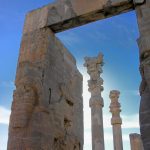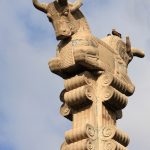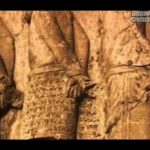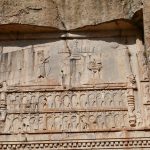
12 Day Iran Rail Tours
“Journey into the Heart of the Persian Empire with all the Comforts of Today’s Modern Trains”
Imagine, traveling in spacious comfort to world famous historic sites, resting at ease in a comfortable train coach as the miles slip past.
Imagine, viewing all the spectacular scenery from your large coach-car windows …seeing this ancient land for yourself as your train passes through the Iranian countryside.

An Iran Railway Pass
Experience resplendent desert sunsets, and watch each memorable landscape recede into the distance as your car glides along the rails.

Imagine, polite jacketed stewards with silver trays serving you at your seat — no need to get up when just a simple nod of the head or the ring of a bell will bring them to your side.
There’s no need for you to just “imagine” how wonderful traveling in Iran by rail can be. Call us today at 1-919-726-2044 or click here to request a free 30 minute travel Q&A session.
….

This 12-day tour is designed for rail enthusiasts who are looking for first-class rail travel combined with the opportunity to see the most important historical sites of Iran. The tour incorporates both rail and road travel in an ambiance of full luxury.
Differing from some similar rail tours of Iran, this itinerary will include as much daytime rail travel as possible. This can be a tricky business because of the nature of Iranian train schedules. This is because not every train runs every day.
During any overnight travels, you will have your own private compartment on a modern Iranian train. Plus your personal guide will accompany you throughout your entire trip.
This tour begins and ends in Tehran. You’ll get to see a beautiful country — Iran is an ancient civilization, home to no fewer than 16 UNESCO World Heritage sites.
You can travel to Iran and take this tour whenever you decide to go. Even if you are a solo traveler you will find that the tour is less expensive than many large-group tours of Iran.
Pricing
- 1 person $5295
- 2 people $3995 per person
- 5 people $3495 per person
- 10 people $3295 per person
- Please note: These prices are for a completely PRIVATE tour. You will NOT be part of a larger group. The prices listed above may be subject to small fluctuations due to Euro exchange rate changes.
….
Leave Any Time – All Train Tours Are Private
Interested? Call us today at 1-919-726-2044 or contact us here for a free travel Q&A session
The map above shows the rail stretches covered by this tour. Every effort has been made to include as much daylight travel as possible so that you can take in the amazing landscape of Iran.
Please note: There will be some days when we will be traveling to our destinations by private vehicle. This is dictated by the Iranian train schedule. Plus there are several stops on the way that could not be seen if all travel were by train.

You will have the chance to visit several UNESCO World Heritage sites, including, of course, the ancient city of Persepolis.

You will be traveling on the very top Iranian State Railway trains, which are very nice indeed.

….

And the meals and food onboard these luxury trains are high quality.
Here is a link to a YouTube video about rail travel in Iran:
Detailed Itinerary of Persian Carpet Train Tour I
This is a very special tour which enables you to see the high points of tourism in Iran as well as to travel on some very interesting rail routes.
Day 1: Landing in Tehran
Arrive in Tehran (IKA Airport ). Most flights from the US arrive late at night or early in the morning. After passing through customs and claiming your baggage, you’ll see your guide, holding a sign with your name on it, waiting for you outside the baggage area.
He or she will be your guide for the whole trip. Your driver will be waiting for you outside. Your hotel is around 40 minutes away. Get a good night’s sleep at the 5-star Espinas Hotel.
Your program for the rest of day will depend on what time your flight arrives. You may just want to rest up. Or you may want to be taken to see some of the attractions that Tehran has to offer.
Stay overnight in Tehran.
Day 2: Touring Tehran
After you enjoy a great buffet breakfast and leave the hotel, you and the guide can decide how you want to spend your time in Tehran.
There are many museums and places of interest, but obviously, you will have to pick and choose which are of the most interest to you. You won’t come close to seeing them all. Tehran is a huge city, with a population of around 12 million people.

The Alborz Mountains, snow-capped most of the year, rise just outside the city in the north. Traffic in Tehran is heavy and chaotic.
The foothills of the Alborz have a number of beautiful restaurants and you might want to tour that area and have dinner there. There is also a cable car that you can take most of the year, offering some very scenic views.

One must-see stop is the Golestan Palace, a Unesco World Heritage site. This was the court and residence of the Qajar Dynasty (1794-1925).

The Palace has many pools and imposing rooms, such as the Mirror Hall.
Tehran has too many museums to visit in the time allotted for this tour. Among them are the National Museum, the Carpet Museum, the National Jewelry Treasury and the Glass and Ceramic Museum.
You can discuss with your guide which museums you most want to visit and then make your choice. You may also decide to visit a local student center, where you would have the opportunity to meet with English-speaking students.

In the evening you can decide to have dinner in one of the colorful restaurants in the foothills of Tehran, north of the city. You may be surprised to see snow on the mountainsides as late as May.
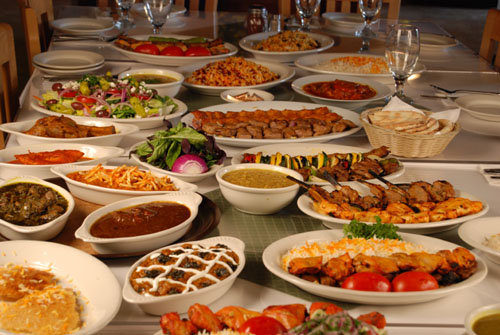
You can also have a very nice dinner at your hotel. Or, close to the hotel, is an interesting local restaurant where you’ll get good local food and see a lot of young people smoking water pipes.
Overnight at Espinas Hotel, Tehran.
Day 3: Tehran to Kashan by Rail
In the morning head for the Tehran train station and board the train for Kashan.
 Kashan, a city famous for its carpets and its bazaar, which was built during the Turkish Seljuk era in 1037. There will be time for a visit to the famous bazaar.
Kashan, a city famous for its carpets and its bazaar, which was built during the Turkish Seljuk era in 1037. There will be time for a visit to the famous bazaar.
Kashan has its distinctive style of carpet and you may decide to bargain for one. This will be followed by visits to two historical houses of wealthy merchants.
While in Kashan, you will be able to visit to the famous Fin Garden, which is one of Iran’s 19 UNESCO World Heritage sites. Dating back to the late 16th Century, it is the oldest existing garden in Iran.

Overnight at a beautiful local hotel, the Saraye Ameriha, which is built in what was once a historic mansion.
Day: 4 and Day 5 Isfahan (Road trip)
 The next two days will be devoted to the exotic city of Isfahan. In the morning, after breakfast, your guide will drive you to the famous city of Isfahan. The trip should take around 2 1/2 hours.
The next two days will be devoted to the exotic city of Isfahan. In the morning, after breakfast, your guide will drive you to the famous city of Isfahan. The trip should take around 2 1/2 hours.
One of the many things that might surprise about Iran is how good their highway system is, with four-lane divided highways throughout the large country.
For many tourists Isfahan is the high point of their trip. It can be called the tourist center of Iran and you are likely to run into many foreign groups there. After arriving in Isfahan and checking into your hotel, it will be time to start seeing some of the many sights of the city.
Isfahan is justly famous for its 11 bridges spanning the Zayandeh River (although the presence of water in the river is seasonal as you can see in one of the shots above).
These bridges are beautiful architectural feats, each one being distinctive and impressive in its own right. You will be able to visit several of these unique bridges and can walk across some of them.

Overnight Isfahan at the 5-star hotel Abbasi Hotel, built in a former royal caravnserai.
Isfahan boasts two UNESCO World Heritage sites: the Meidan Emam Square

You may have already seen photos of the Meidan Emam. The Meidan was built by Shah Abbas I the Great at the beginning of the 17th century, and it is bordered on all sides by monumental buildings linked by a series of two-story arcades.
The site is known for the Royal Mosque, the Mosque of Sheykh Lotfollah, the magnificent Portico of Qaysariyyeh and the 1Sth-century Timurid palace. They are an impressive testimony to the level of social and cultural life in Persia during the Safavid era.
There will be plenty of time to walk around the square, visit some of the adjoining buildings and the great mosque and explore the nearby bazaar. The bazaar itself is huge and you may well find some things to purchase, even carpets (see Q. & A. on buying carpets in Iran).
The second UNESCO site is the Jameh Mosque. Located in the historic center of Isfahan, the Masjed-e Jim (“Friday mosque”™) can be seen as a stunning illustration of the evolution of mosque architecture over twelve centuries, starting in AD 841. This is the oldest preserved edifice of its type in Iran and a prototype for later mosque designs throughout Central Asia.
The complex, covering more than 20,000 m, is also the first Islamic building that adapted the four courtyard layout of Sassanid palaces to Islamic religious architecture. Its double-shelled ribbed domes represent an architectural innovation that inspired builders throughout the region.
The site also features remarkable decorative details representative of stylistic developments over more than a thousand years of Islamic art.

It may even be possible for you to meet with some Muslim clerics who speak English and are interested in discussions with Americans. You may not always agree with what they have to say, but it is guaranteed to be an interesting discussion.
Another place well worth visiting in Isfahan is the Vank Cathedral, established by Armenian immigrants after the Ottoman War of 1603 -1605. The church has beautifully detailed wall paintings which retell Biblical stories. There is also an Armenian museum at the site.
The neighborhood around the Vank Cathedral has become somewhat “trendy”and is an interesting area to walk around and have dinner.
These are only some of the highlights of Isfahan. There is a lot more to see and how much you see depends on how early a start you get in the morning. Your guide and driver will leave as early as you like and together you can decide on your next day’s itinerary.
Overnight Isfahan at the 5-star Abbasi Hotel again.
Day 6: Isfahan – Bam by Train
At 10:45 AM it’s time to board the train for Bam. The trip will run around 6 1/2 hours. This will be a scenic trip through both desert and mountain landscapes. Luckily, the train will be air conditioned.

Upon arrival in Bam check in at your modern hotel. You will stay overnight at the Parisan Azadi Hotel, the best in town.
Day 7: Bam – Kerman by Road
As you probably know, the Bam Citadel, the largest adobe structure in the world and a UNESCO World Heritage site, was severely damaged in the 2003 earthquake. Since then, reconstruction has been going on and it is still a worthwhile place to visit.
Much of the authentic Bam Citadel can still be viewed today. Read the description of present-day and ancient Bam on the UNESCO site.

Then there will be a visit to the Shazdeh Gardens, an outstanding example of a Persian Garden, which, as a group, have been recognized as another UNESCO World Heritage site.
Same Day: Bam – Kerman by Road
After that it will be time to head for the city of Kerman, 180 km. away. Upon arrival there will be time for a visit to the bazaar as well as to the Hamam museum and teahouse.

This was a traditional 19th-Century hamam or Turkish bath which has been transformed into an atmospheric tea house and the museum will show how a hamam bath house really worked.

Overnight at the modern luxury five-star Kerman Pars Hotel, the best in town.
Day 8: Kerman – Shahdad – Yazd by Road

Leaving Kerman, we will drive north to to Shahdad. It is located at the edge of the vast emptiness of the Lut Desert, which is listed as a UNESCO World Heritage site. The desert offers wild scenery of mountains and sand dunes, which you can walk through.

There will also be time for a visit to a desert castle near Shahdad.
Same Day: Continue on to Yazd

The ancient city of Yazd is also a UNESCO World Heritage site. It is one of the oldest continually inhabited cities in the world and is like a living museum.

Yazd was a Zoroastrian center and you will visit the Towers of Silence, where the Zoroastrians would burn the dead. This practice was banned by the last Shah, who saw it as an affront to modernity.
Yazd is also famous for its many badgir (wind towers), a form of ancient air conditioning that kept houses cool in one of the hottest places in Iran. You can see hundreds of these exotic structures and also visit one of the largest of them.
Yazd is a very hot place, especially in the summer months. The construction of the badgir draws out the hot air and brings in cooler air. An ingenious system that was also used to keep ice from the mountains cool in the hottest summers.
….
There will also be a visit to the Zurkhane (house of strength) where every evening men of all ages practice ancient martial arts, twirling 20 kilo (44 pound) clubs.
These practice sessions, accompanied by loud music, are open to the public. Here is a YouTube video of a session…
Day 9: Yazd – Pasargadae – Persepolis – Shiraz by road
This will be a very full day and will require an early start. As you get close to Shiraz you’ll stop at several of the most famous and imposing of Iran’s historical attractions.

The first stop will be at Pasrgadae. Pasargadae is a UNESCO World Heritage site. It was the first dynastic capital of the Achaemenid Empire, founded by Cyrus ll the Great in the 6th century BC.
- Pasargadae (Tomb of Cyrus) Iran
Its palaces, gardens and the mausoleum of Cyrus are outstanding examples of the first phase of royal Achaemenid art and architecture and exceptional testimonies of Persian civilization.

Particularly noteworthy vestiges include: the Mausoleum of Cyrus ll; Tall-e Takht, a fortified terrace; and a royal ensemble of gatehouse, audience hall, residential palace and gardens.
Pasargadae was the capital of the first great multicultural empire in Western Asia. Spanning the Eastern Mediterranean and Egypt to the Hindus River,
it is considered to be the first empire that respected the cultural diversity of its different peoples. This was reflected in Achaemenid architecture, a synthetic representation of different cultures.
Here is a link to a short video about this UNESCO site.
From there we drive on to Persepolis.
Persepolis is probably the most famous single historical site in lran and a UNESCO World Heritage Site as well.

When it was founded by Darius III in 518 BC, Persepolis was the capital of the Achaemenid Empire, where the king of kings created an impressive palace complex inspired by Mesopotamian models. The importance and quality of the monumental ruins make it a unique archaeological site.
- Persepolis, Iran
Persepolis was the example par excellence of the dynastic city, the symbol of the Achaemenid Dynasty, which is why it was burned by the Greeks of Alexander the Great in 330. According to Plutarch, they carried away its treasures on 20,000 mules and 5,000 camels.
What remains today, dominating the city, is the immense stone terrace (530 meters by 330 meters), half-natural, half-artificial, backed against the mountains.
A short distance from Persepolis is Naghsh-e-Rostam, a proposed UNESCO World Heritage site.

This is one of our favorite sites in Iran. You will see four tombs belonging to Achaemenid kings carved out of the rock face at a considerable height above the ground. They are somewhat reminiscent of Petra in Jordan, but much, much easier to get to.

The tombs are known locally as the “Persian crosses” after the shape of the facades of the tombs.
….
In addition, there are seven over-life-sized rock reliefs at the site, depicting monarchs of the Sassanid period. It is believed that they were created to celebrate a great victory of ancient times.

After all this you will be glad to arrive at your hotel, the luxurious Grand Hotel Shiraz, built into the side of a cliff. You will stay overnight in Shiraz.
Day 10: Tour Shiraz
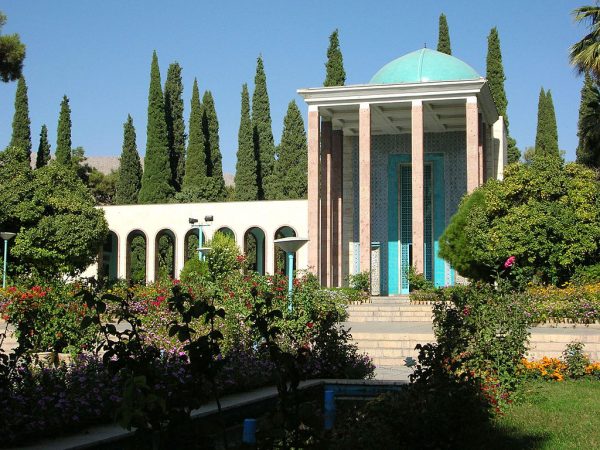 This day will be devoted to touring the wonders of Shiraz. There is time to relax, since many sites are closed during the height of the afternoon heat.
This day will be devoted to touring the wonders of Shiraz. There is time to relax, since many sites are closed during the height of the afternoon heat.
Again, there are many things to see in Shiraz, too many to all be included in a relatively short visit. You can discuss with your guide how to decide which ones to visit.
Visits will be made to the Pars Museum, the Citadel and the Masjid-I Nasir al-Mulk (Pink Mosque).
Of course, getting an early start will also enable you to see more. Also, since all of our tours are custom tours, you can elect to spend an extra night or two in Shiraz.
Overnight in Shiraz.
Day 11: Touring Shiraz – Shiraz to Tehran by Rail
 Among the places to see are Karim Khan complex, resembling a medieval fortress; the mausoleum of the 8th-Century poet Hafez, the main Bazaar, established in the 11th Century.
Among the places to see are Karim Khan complex, resembling a medieval fortress; the mausoleum of the 8th-Century poet Hafez, the main Bazaar, established in the 11th Century.
Then there the world famous Eram Gardens. The Eram Gardens are a series of Persian gardens, which as a whole, have been designated a UNESCO World Heritage site.
In the evening, you will to head to the railroad station and board the train for the overnight trip back to Tehran. You will overnight in your private train compartment.

Day 12: Return Tehran by Train
 Check back into the Espinas Hotel, rest up or tour more of Tehran. Then head to the airport for your flight home.
Check back into the Espinas Hotel, rest up or tour more of Tehran. Then head to the airport for your flight home.
Ready to Book Your Tour to Iran Today? Leave Any Time – All Tours Are Private. You can rely on our experience and expertise to answer all your questions.
It all starts with a simple conversation. Either call us at 1-919-726-2044 or click the link below for more information about Iran custom tours > How to Book One of Our Luxury Tours to Iran (everything you need to know)
































